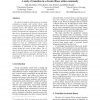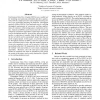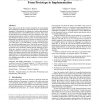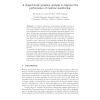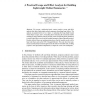HICSS
2006
IEEE
15 years 7 months ago
2006
IEEE
We report on analysis of discussions in an online community of people with chronic illness using socio-cognitively motivated, automatically produced semantic spaces. The analysis ...
ACSD
2006
IEEE
15 years 7 months ago
2006
IEEE
Synchronous Data Flow Graphs (SDFGs) are a useful tool for modeling and analyzing embedded data flow applications, both in a single processor and a multiprocessing context or for...
VLDB
2007
ACM
15 years 7 months ago
2007
ACM
We present BlogScope (www.blogscope.net), a system for online analysis of temporally ordered streaming text, currently applied to the analysis of the Blogosphere1 . The system cur...
105
click to vote
TSD
2007
Springer
15 years 7 months ago
2007
Springer
We present a study of the prosody – seen in a broader sense – that supports the theory of the interrelationship function of speech. “Pure emotions” are meant to show a rela...
101
click to vote
SAS
2007
Springer
15 years 7 months ago
2007
Springer
We present a new pointer analysis for use in shared memory programs running on hierarchical parallel machines. The analysis is motivated by the partitioned global address space lan...
SAS
2007
Springer
15 years 7 months ago
2007
Springer
Existing shape analysis algorithms infer descriptions of data structures at program points, starting from a given precondition. We describe an analysis that does not require any pr...
104
click to vote
PPDP
2007
Springer
15 years 7 months ago
2007
Springer
Static analyses provide the semantic foundation for tools ranging from optimizing compilers to refactoring browsers and advanced debuggers. Unfortunately, developing new analysis ...
FPL
2007
Springer
15 years 7 months ago
2007
Springer
In this paper we present Minibit+, an approach that optimizes the bit-widths of fixed-point and floating-point designs, while guaranteeing accuracy. Our approach adopts differen...
109
click to vote
ECOOP
2007
Springer
15 years 7 months ago
2007
Springer
In runtime monitoring, a programmer specifies a piece of code to execute when a trace of events occurs during program execution. Our work is based on tracematches, an extension to...
CC
2007
Springer
15 years 7 months ago
2007
Springer
We present a unification-based, context-sensitive escape and effect analysis that infers lightweight method summaries describing heap effects. The analysis is parameterized on two...
